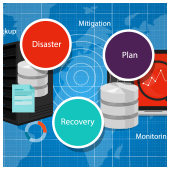New threats to businesses’ precious employee and customer data emerge every day, so the only surefire way to protect your files from viruses, theft, and other unforeseeable disasters is to partner with a leading cloud backup provider. With a basic understanding of how cloud backups work, you can set up a plan that is economical and customized to the needs of your business.
How should you go about choosing a cloud backup provider? Let’s take a look:
Learn more about their storage capacity
Before partnering with a cloud backup provider, ask them where they store their data. Many providers use cloud servers over which they have little control, which could be hazardous as it makes it harder to monitor activity and respond to anomalies. To avoid this fate, choose a backup service that operates their own cloud-based servers.
Next, you will have to determine whether your business assets can be backed up, since some cloud storage providers do not have the capacity to save bigger files like videos or other multimedia files. By asking these questions, you can find a cloud backup service that fits your business needs, and more importantly, can take care of all your files.
Get details on their security
It will be important for the cloud backup provider to explain in no uncertain terms how they will store your files. They should be encrypted and stored on multiple servers because redundant storage ensures your data has multiple copies saved online and can be retrieved at will. Even if an uncontrollable disaster befalls your company or the backup provider’s system, you’ll still be safe.
Compare your budget and backup costs
Before considering any cloud backup provider, you need to know how much the service is worth to you. How much money would you lose if your server crashed and all the data it stored was irretrievable? Compare that amount with the cost of a provider’s service, which could be charged by storage tiers, per gigabyte, or on a flat-fee unlimited plan.
When asking about the price of cloud backups, make sure to clarify any service limitations or restrictions. For example, how quickly can your storage capacity be upgraded? Is it possible to run out of storage? These are not things you want to discover in the middle of hurricane season.
Clarify data recovery timelines
Although storage availability is important, how quickly backups can be created and restored is also an essential factor. Ask providers how often backups will be created (e.g., hourly, daily, weekly), and how long it will take to restore them (e.g., hours, days, etc.). If those timelines are too long, it may be time to look for a better provider.
The most important thing is to know your needs before meeting with a potential provider. Let them know your business needs, budget, and recovery timelines. Our solutions and pricing are flexible and customized to your needs so you’re not stuck in a cookie-cutter plan.
Give us a call to find out more about cloud backup service and other dynamic ways to protect your data.

 The massive success of ransomware like WannaCry and Petya have spurred other cybercriminals to develop their own ransomware and sell it on the black market. This means we can expect more ransomware attacks in the future. To prepare your business, you need virtualized disaster recovery solutions. Here’s why.
The massive success of ransomware like WannaCry and Petya have spurred other cybercriminals to develop their own ransomware and sell it on the black market. This means we can expect more ransomware attacks in the future. To prepare your business, you need virtualized disaster recovery solutions. Here’s why. Mark Zuckerberg and Elon Musk are not the only ones dabbling with AI and machine learning. According to Cisco, these technologies might be key to the future of IT system management and business continuity, both of which have grown increasingly complex over the years.
Mark Zuckerberg and Elon Musk are not the only ones dabbling with AI and machine learning. According to Cisco, these technologies might be key to the future of IT system management and business continuity, both of which have grown increasingly complex over the years. Hurricanes Harvey and Irma have already caused billions of dollars in damages, but hurricane season is far from over. Experts are predicting that there will be five more major tropical storms through October, and if they present risks to your business, it’s time to establish a watertight disaster recovery (DR) plan. Here are a few things you need to consider.
Hurricanes Harvey and Irma have already caused billions of dollars in damages, but hurricane season is far from over. Experts are predicting that there will be five more major tropical storms through October, and if they present risks to your business, it’s time to establish a watertight disaster recovery (DR) plan. Here are a few things you need to consider. While it’s easy to turn a blind eye against hurricane warnings and think “I already have a business continuity plan in place”, it pays to be extremely cautious, especially when the National Oceanic and Atmospheric Administration (NOAA) predicts up to four unusually active hurricanes this year. Needless to say, you simply can’t afford not to hurricane-proof your disaster recovery (DR) plan.
While it’s easy to turn a blind eye against hurricane warnings and think “I already have a business continuity plan in place”, it pays to be extremely cautious, especially when the National Oceanic and Atmospheric Administration (NOAA) predicts up to four unusually active hurricanes this year. Needless to say, you simply can’t afford not to hurricane-proof your disaster recovery (DR) plan. The WannaCry ransomware, a type of malware that encrypts a victim’s files and extorts them for money, has already affected thousands of machines worldwide. Unfortunately, the success of this attack is just the beginning. According to security researchers, other hackers will probably develop stronger WannaCry variants in the coming months. And if you don’t want your business to become a victim of these attacks, you must take the following precautions.
The WannaCry ransomware, a type of malware that encrypts a victim’s files and extorts them for money, has already affected thousands of machines worldwide. Unfortunately, the success of this attack is just the beginning. According to security researchers, other hackers will probably develop stronger WannaCry variants in the coming months. And if you don’t want your business to become a victim of these attacks, you must take the following precautions. It makes a lot of sense for electronics firms to pack a variety of functions into mobile devices and expand their usefulness. Instead of confining their use to communications, companies such as Apple, Samsung, and others have turned mobile phones into mini-computers that can serve as a substitute for your laptop, or as a storage device. If you’re using mobile phones as a communications and storage device, backing up now would be a wise move.
It makes a lot of sense for electronics firms to pack a variety of functions into mobile devices and expand their usefulness. Instead of confining their use to communications, companies such as Apple, Samsung, and others have turned mobile phones into mini-computers that can serve as a substitute for your laptop, or as a storage device. If you’re using mobile phones as a communications and storage device, backing up now would be a wise move. Failing to stop a cyber attacker, or to pass a disaster recovery plan (DRP) audit could be the product of focusing your efforts on the wrong educational resources. Because no matter how many conferences you attend, or how many certifications you receive, nothing beats real-world case studies. If that’s what you’re looking for, a state government office just gave us plenty to pore over. See for yourself.
Failing to stop a cyber attacker, or to pass a disaster recovery plan (DRP) audit could be the product of focusing your efforts on the wrong educational resources. Because no matter how many conferences you attend, or how many certifications you receive, nothing beats real-world case studies. If that’s what you’re looking for, a state government office just gave us plenty to pore over. See for yourself. When disaster strikes, organizations need to put their business continuity plans into action and recover their IT systems as quickly as possible. Failing to do so can mean serious financial and reputational repercussions. Despite this, investments in disaster recovery are set aside each year for high-tech IT investments, and every year companies and employees continue to suffer for it. Here are some reasons why disaster recovery is well worth your time, effort, and resources in 2017.
When disaster strikes, organizations need to put their business continuity plans into action and recover their IT systems as quickly as possible. Failing to do so can mean serious financial and reputational repercussions. Despite this, investments in disaster recovery are set aside each year for high-tech IT investments, and every year companies and employees continue to suffer for it. Here are some reasons why disaster recovery is well worth your time, effort, and resources in 2017. Data is vital to your business. It’s how you keep records, track activities, and function as a business in general. However, with all of the data that your business generates on a regular basis, it can be difficult to keep everything backed up at all times. Fortunately, there is a way to better prioritize your data backups. By appropriating one of the IT industry’s favorite solutions, you can revolutionize your data backup protocols.
Data is vital to your business. It’s how you keep records, track activities, and function as a business in general. However, with all of the data that your business generates on a regular basis, it can be difficult to keep everything backed up at all times. Fortunately, there is a way to better prioritize your data backups. By appropriating one of the IT industry’s favorite solutions, you can revolutionize your data backup protocols.